W-Band FMCW MIMO System for 3-D Imaging Based on Sparse Array
Abstract
1. Introduction
- Existing high-frequency security equipment is mostly used for long-distance security checks; for example, at an imaging distance of 10~50 m, and the azimuth resolution is generally not less than 14 mm. The security equipment used for close-range imaging generally operates at a frequency of 24~35 GHz and has an azimuth resolution of no less than 8 mm. The imaging system proposed in this article operates at a frequency of 70~80 GHz and can achieve a limited azimuth resolution of 2 mm for objects in an imaging area of 10~60 cm, which meets the increasingly improving imaging resolution requirements. This frequency band also balances imaging resolution and electromagnetic wave penetration into objects.
- The existing MIMO imaging systems require hundreds or even thousands of transmitting and receiving antennas, even if using sparse array structures. The numerous and complex array units result in high hardware costs. The imaging system proposed in this article adopts a periodic array structure in order to improve the utilization of the antenna units. By combining a one-dimensional sparse MIMO array with mechanical scanning, a two-dimensional planar aperture is formed, which reduces hardware costs.
- Conventional channel calibration methods necessitate an additional reference channel positioned separately from the receiving channel [20]. However, these methods have their drawbacks, including an inability to perform real-time calibration, inconvenience in the calibration process, and systematic errors. The self-calibration method in this article utilizes the receiving channel exclusively, and avoids extra hardware. The software separates and calibrates the direct wave, streamlining the process and enabling real-time calibration without electrical parameter drift issues.
2. MIMO Signal Model and Processing
2.1. FMCW Signal Model
2.2. 3-D MIMO Omega-k Algorithm
2.3. Element Spacing and Spatial Resolution
2.4. MIMO Array Design and Implementation
2.5. Point Spread Function Simulations
3. Radar System Description
3.1. System Structure
3.2. RF Chip
3.3. Channel Calibration
- Perform a fast Fourier transform on the received signal to obtain the transformed received signal;
- Select the direct wave in the frequency domain from the transformed received signal through a preset frequency domain window;
- Perform an inverse fast Fourier transform on the direct wave in the frequency domain to obtain the direct wave.
4. Measurement Results
5. Conclusions
Author Contributions
Funding
Data Availability Statement
Conflicts of Interest
Abbreviations
| MIMO | multiple-input multiple-output |
| FMCW | frequency modulated continuous wave |
| 3-D | three-dimensional |
| 2-D | two-dimensional |
| SISO | single-input-single-output |
| SAR | synthetic aperture radar |
| RMA | range migration algorithm |
| EPC | equivalent phase center |
| PSF | point spread function |
| RF | radio frequency |
References
- Sheen, D.M.; McMakin, D.L.; Hall, T.E. Three-Dimensional Millimeter-Wave Imaging for Concealed Weapon Detection. IEEE Trans. Microw. Theory Tech. 2001, 49, 1581–1592. [Google Scholar] [CrossRef]
- Yeom, S.; Lee, D.; Lee, H.; Son, J.; Gushin, V.P. Distance Estimation of Concealed Objects with Stereoscopic Passive Milimeter-wave Imaging. PIER 2011, 115, 399–407. [Google Scholar] [CrossRef][Green Version]
- Appleby, R.; Anderton, R.N. Millimeter-Wave and Submillimeter-Wave Imaging for Security and Surveillance. Proc. IEEE 2007, 95, 1683–1690. [Google Scholar] [CrossRef]
- Kemp, M.C. Millimetre Wave and Terahertz Technology for Detection of Concealed Threats-A Review. In Proceedings of the 2007 Joint 32nd International Conference on Infrared and Millimeter Waves and the 15th International Conference on Terahertz Electronics, Cardiff, UK, 2–9 September 2007; IEEE: Cardiff, UK, 2007; pp. 647–648. [Google Scholar]
- Sheen, D.M.; Hall, T.E.; Severtsen, R.H.; McMakin, D.L.; Hatchell, B.K.; Valdez, P.L.J. Standoff Concealed Weapon Detection Using a 350-GHz Radar Imaging System. In Passive Millimeter-Wave Imaging Technology XIII; Wikner, D.A., Luukanen, A.R., Eds.; SPIE: Orlando, FL, USA, 2010; p. 767008. [Google Scholar]
- Ahmed, S.S.; Schiessl, A.; Schmidt, L.-P. A Novel Fully Electronic Active Real-Time Imager Based on a Planar Multistatic Sparse Array. IEEE Trans. Microw. Theory Tech. 2011, 59, 3567–3576. [Google Scholar] [CrossRef]
- Cooper, K.B.; Dengler, R.J.; Llombart, N.; Thomas, B.; Chattopadhyay, G.; Siegel, P.H. THz Imaging Radar for Standoff Personnel Screening. IEEE Trans. Terahertz Sci. Technol. 2011, 1, 169–182. [Google Scholar] [CrossRef]
- Ahmed, S.S.; Gumbmann, F.; Schiessl, A.; Reiband, M.; Methfessel, S.; Maire, C.; Cenanovic, A.; Ostwald, O.; Evers, C.; Schmidt, L.-P. QPASS-Quick Personnel Automatic Safe Screening for Security Enhancement of Passengers. In Proceedings of the Future Security Conference, Berlin, Germany, 8 November 2011. [Google Scholar]
- Schiessl, A.; Genghammer, A.; Ahmed, S.S.; Schmidt, L.P. Hardware realization of a 2m × 1m fully electronic real-time mm-wave imaging system. In Proceedings of the EUSAR 2012, 9th European Conference on Synthetic Aperture Radar, Nuremberg, Germany, 23–26 April 2012; pp. 40–43. [Google Scholar]
- Ahmed, S.S.; Schmidt, L.P. Illumination of humans in active millimeter-wave multistatic imaging. In Proceedings of the European Conference on Antennas and Propagation, Prague, Czech Republic, 26–30 March 2012; pp. 1755–1757. [Google Scholar]
- Ahmed, S.S.; Schiessl, A.; Schmidt, L.P. A novel active real-time digital-beamforming imager for personnel screening. In Proceedings of the European Conference on Synthetic Aperture Radar, Nuremberg, Germany, 23–26 April 2012; pp. 178–181. [Google Scholar]
- Gu, S.; Li, C.; Gao, X.; Sun, Z.; Fang, G. Terahertz Aperture Synthesized Imaging with Fan-Beam Scanning for Personnel Screening. IEEE Trans. Microw. Theory Tech. 2012, 60, 3877–3885. [Google Scholar] [CrossRef]
- Gu, S.; Li, C.; Gao, X.; Sun, Z.; Fang, G. Three-Dimensional Image Reconstruction of Targets Under the Illumination of Terahertz Gaussian Beam—Theory and Experiment. IEEE Trans. Geosci. Remote Sens. 2013, 51, 2241–2249. [Google Scholar] [CrossRef]
- Zhang, B.; Pi, Y.; Li, J. Terahertz Imaging Radar With Inverse Aperture Synthesis Techniques: System Structure, Signal Processing, and Experiment Results. IEEE Sens. J. 2015, 15, 290–299. [Google Scholar] [CrossRef]
- Zhang, B. Research on Imaging Algorithm of Terahertz Radar. Ph.D. Thesis, University of Electronic Science and Technology of China, Chengdu, China, 9 November 2023. [Google Scholar] [CrossRef]
- Grajal, J.; Badolato, A.; Rubio-Cidre, G.; Ubeda-Medina, L.; Mencia-Oliva, B.; Garcia-Pino, A.; Gonzalez-Valdes, B.; Rubinos, O. 3-D High-Resolution Imaging Radar at 300 GHz With Enhanced FoV. IEEE Trans. Microw. Theory Tech. 2015, 63, 1097–1107. [Google Scholar] [CrossRef]
- Garcia-Rial, F.; Montesano, D.; Perez-Eijo, L.; Arias, M.; Gonzalez-Valdes, B.; Pino, A.; Grajal, J. Evaluation of Standoff Multistatic 3-D Radar Imaging at 300 GHz. IEEE Trans. Terahertz Sci. Technol. 2020, 10, 58–67. [Google Scholar] [CrossRef]
- Bleh, D.; Rosch, M.; Kuri, M.; Dyck, A.; Tessmann, A.; Leuther, A.; Wagner, S.; Weismann-Thaden, B.; Stulz, H.-P.; Zink, M.; et al. W-Band Time-Domain Multiplexing FMCW MIMO Radar for Far-Field 3-D Imaging. IEEE Trans. Microw. Theory Tech. 2017, 65, 3474–3484. [Google Scholar] [CrossRef]
- Gao, J.; Cui, Z.; Cheng, B.; Qin, Y.; Deng, X.; Deng, B.; Li, X.; Wang, H. Fast Three-Dimensional Image Reconstruction of a Standoff Screening System in the Terahertz Regime. IEEE Trans. Terahertz Sci. Technol. 2018, 8, 38–51. [Google Scholar] [CrossRef]
- Korner, G.; Oppelt, D.; Adametz, J.; Vossiek, M. Novel Passive Calibration Method for Fully Polarimetric Near Field MIMO Imaging Radars. In Proceedings of the 2019 12th German Microwave Conference (GeMiC), Stuttgart, Germany, 25–27 March 2019. [Google Scholar]
- Shin, D.H.; Jung, D.H.; Kim, D.C.; Ham, J.W.; Park, S.O. A distributed FMCW radar system based on Fiber-Optic links for small drone decetion. IEEE Trans. Instrum. Meas. 2017, 66, 340–347. [Google Scholar] [CrossRef]
- Raney, R.K.; Runge, H.; Bamler, R.; Cumming, I.G.; Wong, F.H. Precision SAR Processing Using Chirp Scaling. IEEE Trans. Geosci. Remote Sens. 1994, 32, 786–799. [Google Scholar] [CrossRef]
- Zhu, D.; Zhu, Z. Range Resampling in the Polar Format Algorithm for Spotlight SAR Image Formation Using the Chirp z-Transform. IEEE Trans. Signal Process. 2007, 55, 1011–1023. [Google Scholar] [CrossRef]
- Yang, J.; Huang, X.; Jin, T.; Thompson, J.; Zhou, Z. Synthetic Aperture Radar Imaging Using Stepped Frequency Waveform. IEEE Trans. Geosci. Remote Sens. 2012, 50, 2026–2036. [Google Scholar] [CrossRef]
- Zhuge, X.; Yarovoy, A.G. Three-Dimensional Near-Field MIMO Array Imaging Using Range Migration Techniques. IEEE Trans. Image Process. 2012, 21, 3026–3033. [Google Scholar] [CrossRef]
- Zhuge, X.; Yarovoy, A.G. Sparse Multiple-Input Multiple-Output Arrays for High-Resolution near-Field Ultra-Wideband Imaging. IET Microw. Antennas Propag. 2011, 5, 1552. [Google Scholar] [CrossRef]
- Zhuge, X.; Yarovoy, A.G. Study on Two-Dimensional Sparse MIMO UWB Arrays for High Resolution Near-Field Imaging. IEEE Trans. Antennas Propag. 2012, 60, 4173–4182. [Google Scholar] [CrossRef]
- Ahmed, S.S.A. Electronic Microwave Imaging with Planar Multistatic Arrays; Logos Verlag: Berlin/Heidelberg, Germany, 2015; pp. 101–106. [Google Scholar]
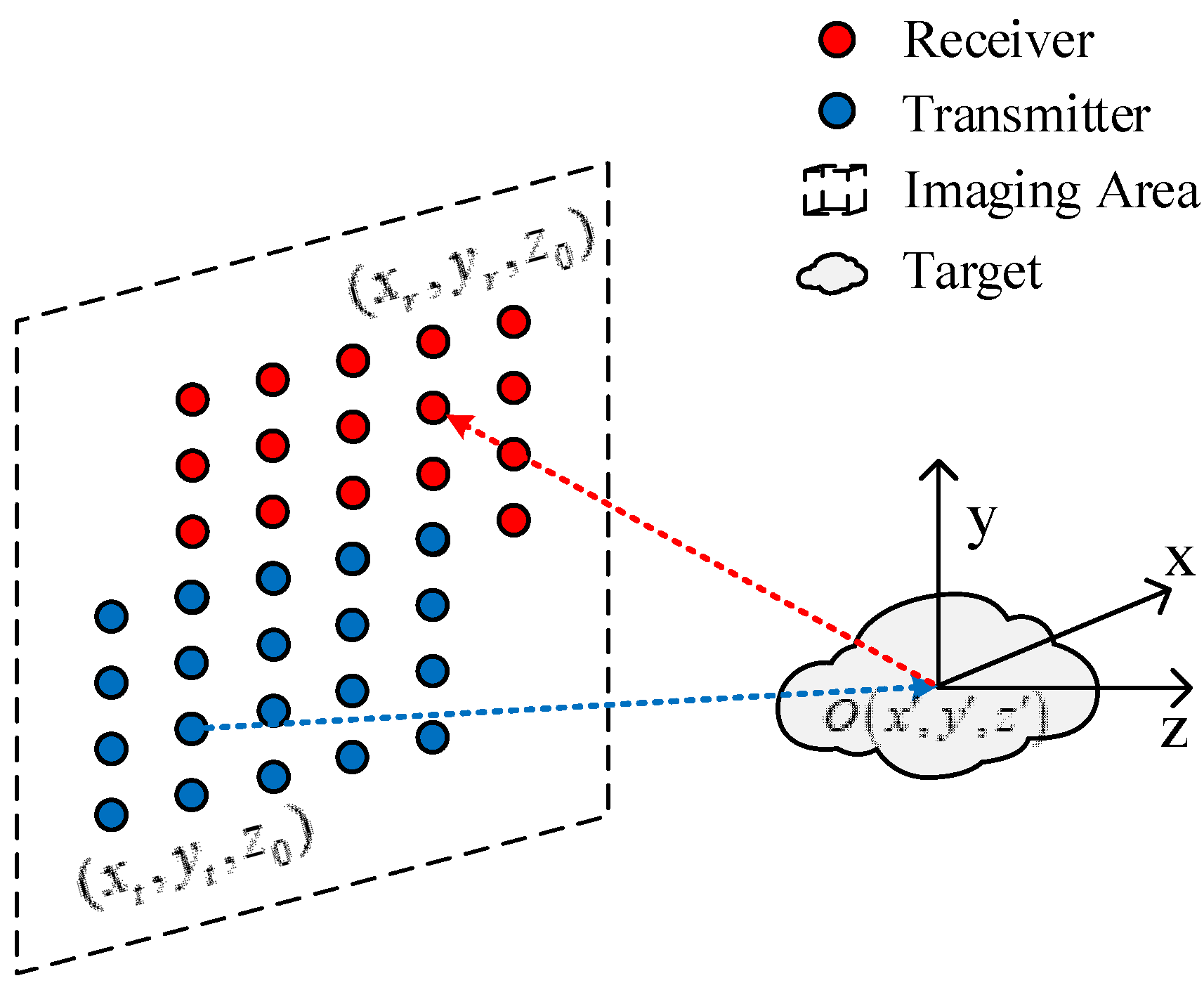
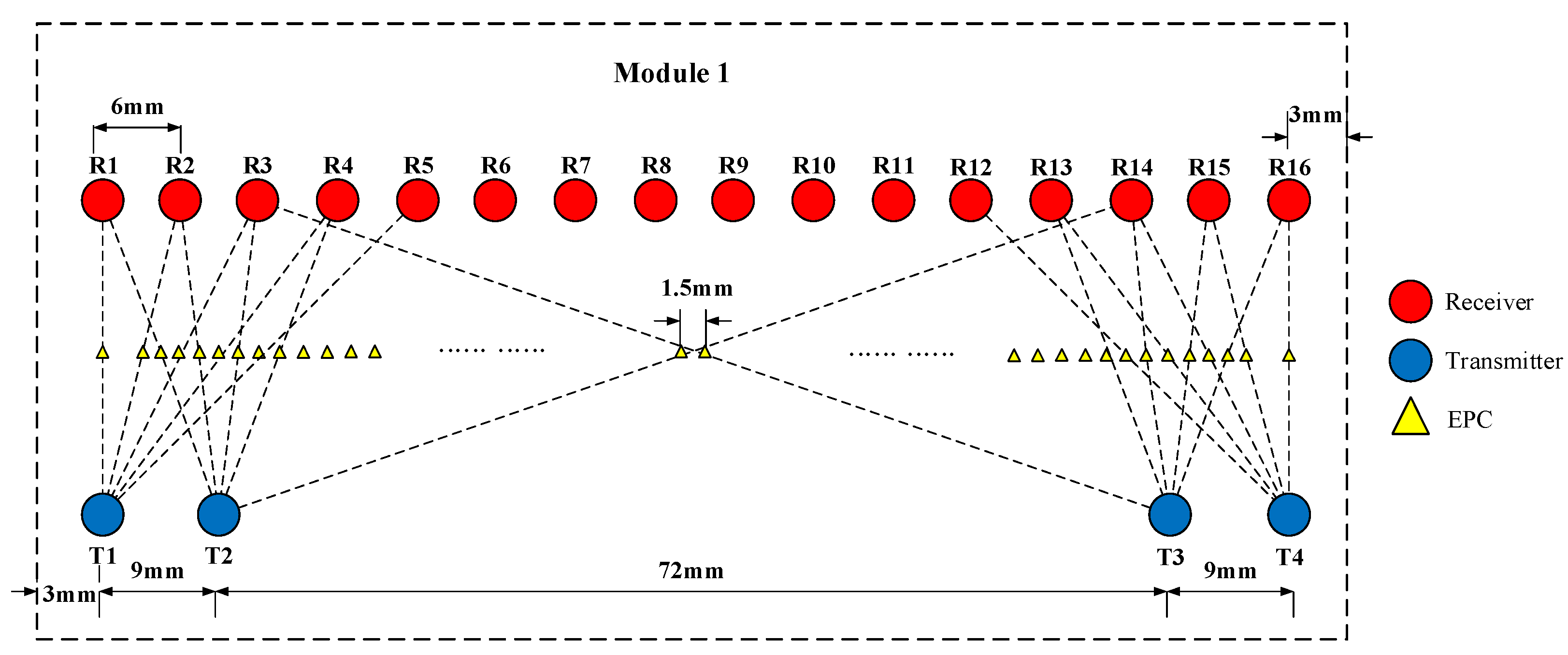
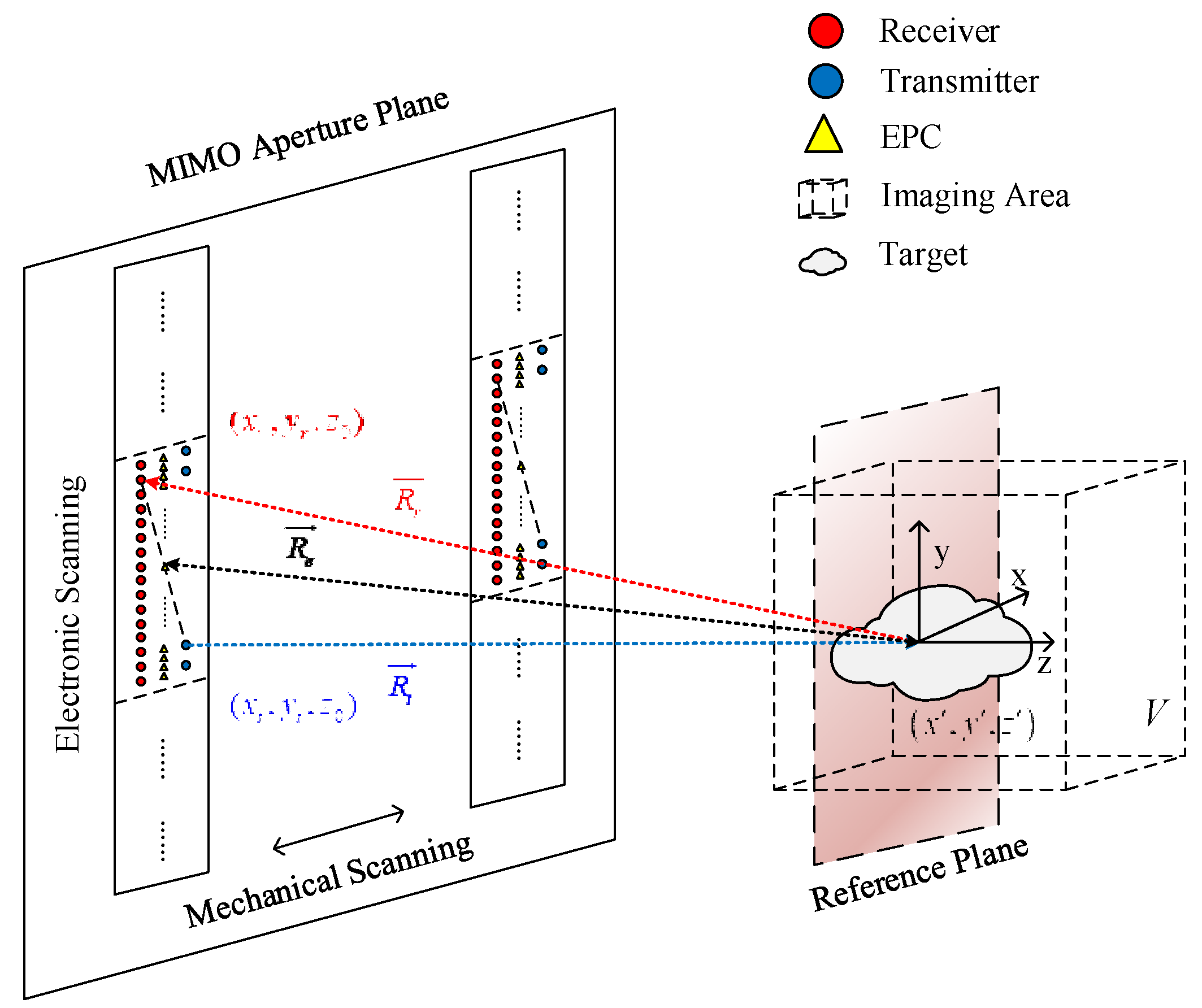

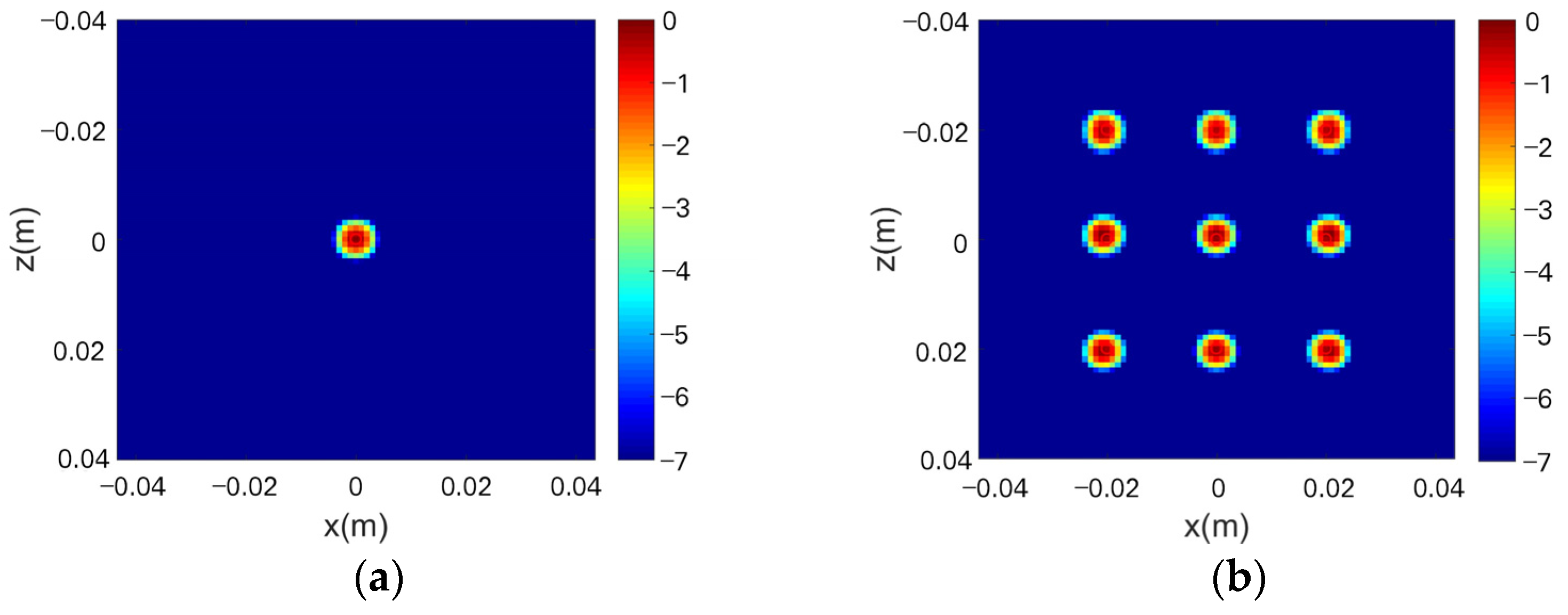
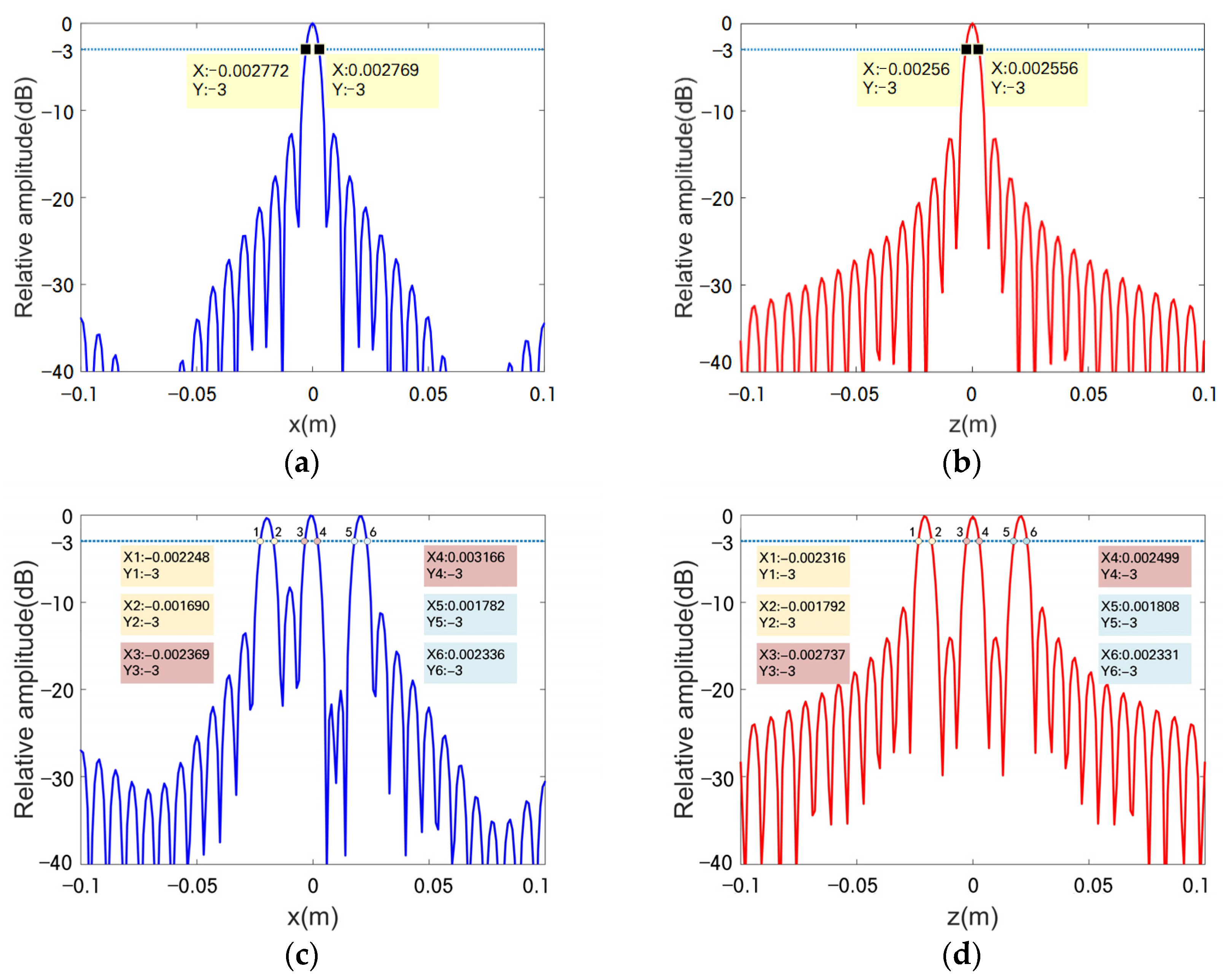

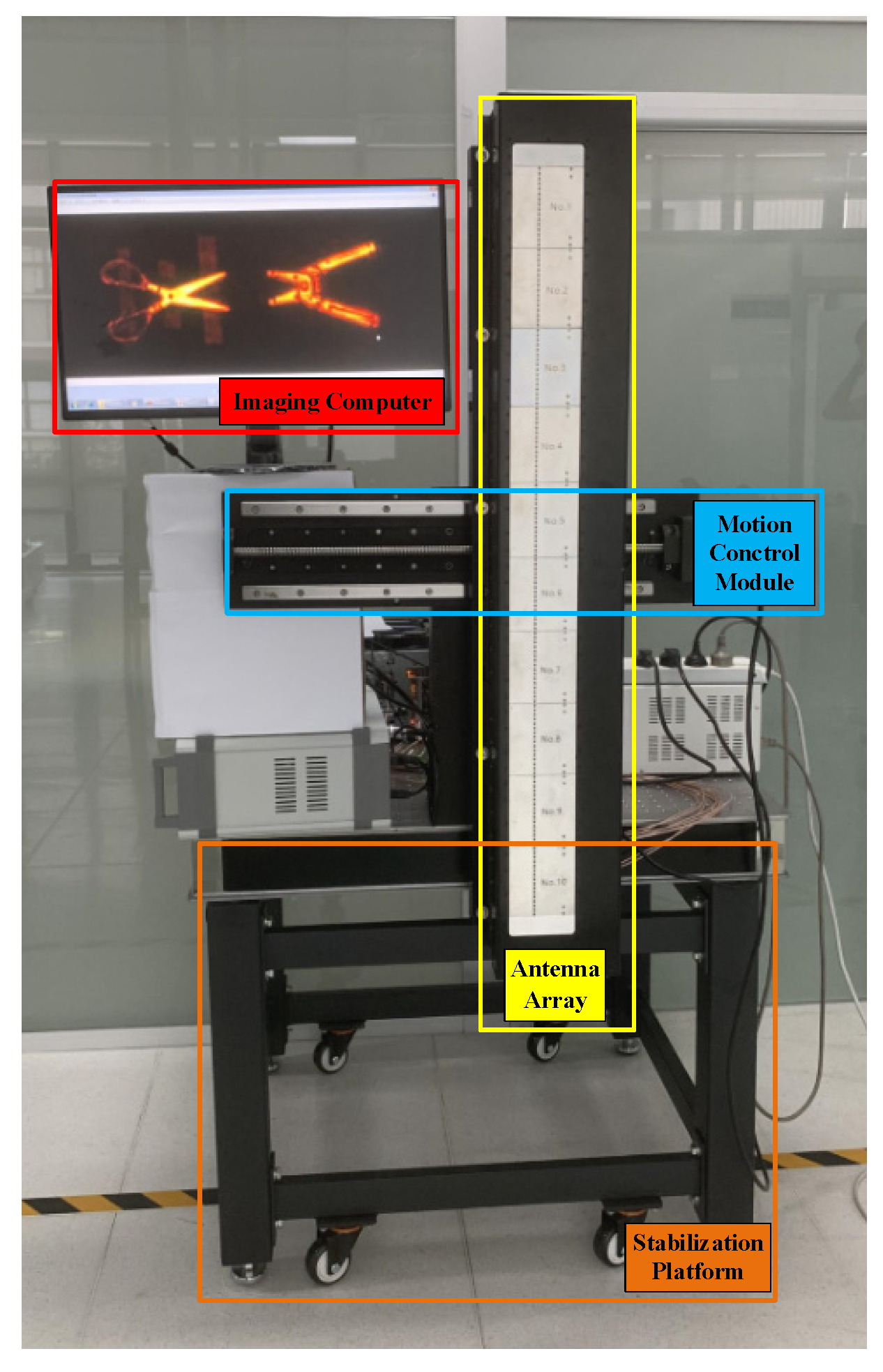



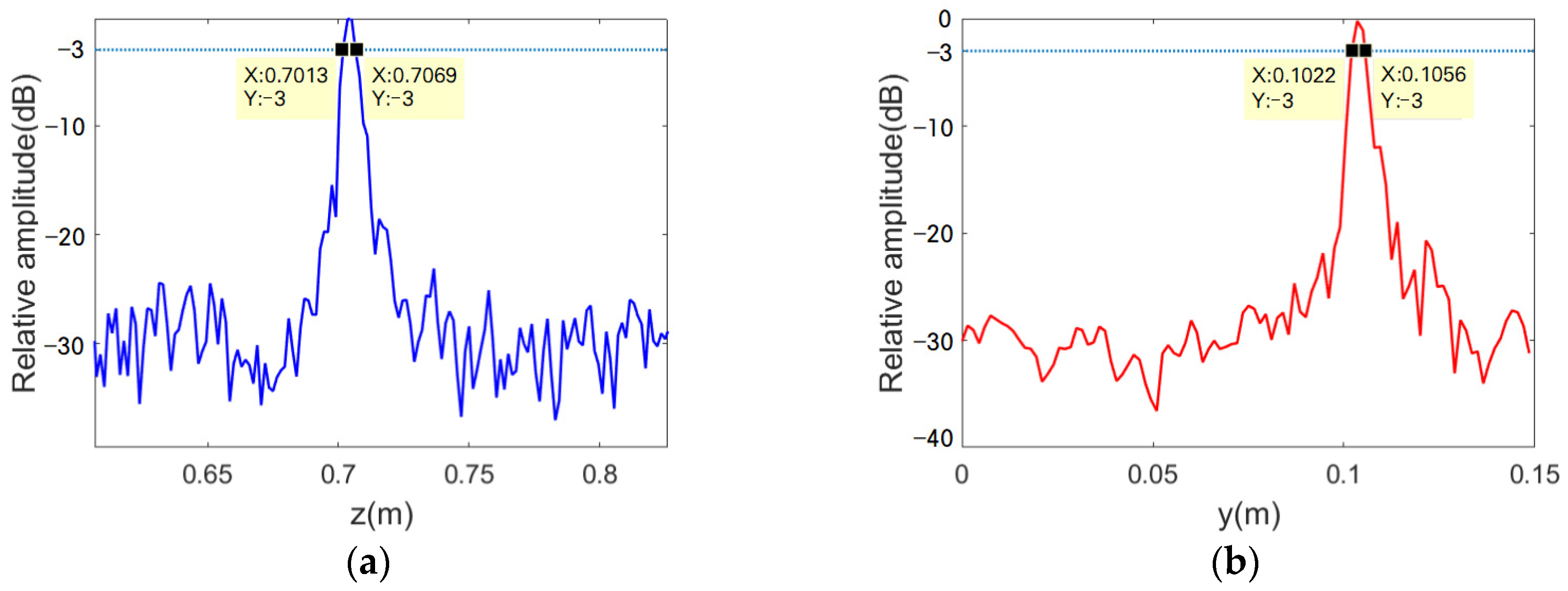
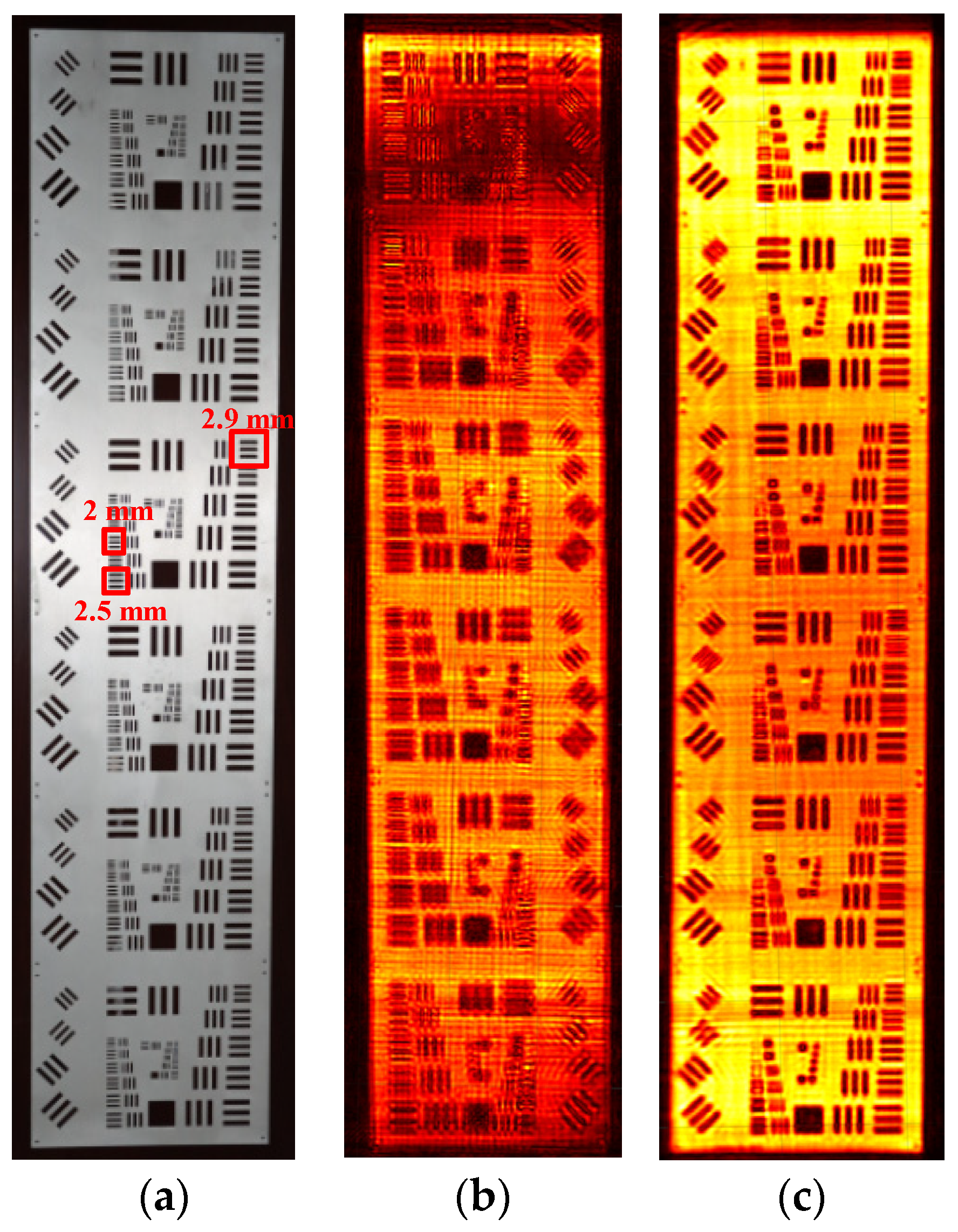


Disclaimer/Publisher’s Note: The statements, opinions and data contained in all publications are solely those of the individual author(s) and contributor(s) and not of MDPI and/or the editor(s). MDPI and/or the editor(s) disclaim responsibility for any injury to people or property resulting from any ideas, methods, instructions or products referred to in the content. |
© 2024 by the authors. Licensee MDPI, Basel, Switzerland. This article is an open access article distributed under the terms and conditions of the Creative Commons Attribution (CC BY) license (https://creativecommons.org/licenses/by/4.0/).
Share and Cite
Shao, W.; Hu, J.; Ji, Y.; Zhang, W.; Fang, G. W-Band FMCW MIMO System for 3-D Imaging Based on Sparse Array. Electronics 2024, 13, 369. https://doi.org/10.3390/electronics13020369
Shao W, Hu J, Ji Y, Zhang W, Fang G. W-Band FMCW MIMO System for 3-D Imaging Based on Sparse Array. Electronics. 2024; 13(2):369. https://doi.org/10.3390/electronics13020369
Chicago/Turabian StyleShao, Wenyuan, Jianmin Hu, Yicai Ji, Wenrui Zhang, and Guangyou Fang. 2024. "W-Band FMCW MIMO System for 3-D Imaging Based on Sparse Array" Electronics 13, no. 2: 369. https://doi.org/10.3390/electronics13020369
APA StyleShao, W., Hu, J., Ji, Y., Zhang, W., & Fang, G. (2024). W-Band FMCW MIMO System for 3-D Imaging Based on Sparse Array. Electronics, 13(2), 369. https://doi.org/10.3390/electronics13020369




